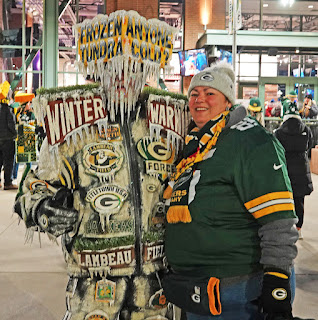By Eric Goska
 |
| Josh Jacobs is all smiles during training camp. (photos by Eric Goska) |
Josh Jacobs has been accumulating rushing yards at a record
pace. That he came up short of eclipsing 1,000 yards for the season Thursday
night against the Dolphins does not negate the impact he has made since joining
the Packers.
Jacobs again paved the way on the ground as Green Bay
disposed of Miami 30-17 on Thanksgiving. The hard-charging running back also put
his receiving skills on display as the Packers won their third straight to
improve to 9-3.
Packers general manager Brian Gutekunst acquired Jacobs via
free agency in March. After five seasons with the Raiders, Jacobs was ready to
make a change.
“I knew it (Green Bay) was a city where it’s nothing but
football,” he told Ryan Wood of the Green Bay Press-Gazette in July. “So it’s
like what you put in is exactly what you’re going to get.”
Jacobs has put in the work. The results have been impressive.
The NFL’s leading rusher in 2022 (1,653 yards), Jacobs has
led the Packers in rushing attempts and rushing yards in 11 of 12 games. Jacobs’
lone shortfall came in Nashville where his 43 yards ranked third behind the 73
of Malik Willis and 50 of Emanuel Wilson.
In the time since, Jacob has paced the team in both departments
(carries and yards) nine straight times.
Jacobs found tough sledding against Miami. He gained 43
yards on 19 totes.
As usual, Jacobs was most productive in the first quarter. He
churned out 30 yards and three first downs. He ripped off his longest gain (11)
on a 12-play, 76-yard advance that he capped with a 1-yard plunge to put Green
Bay up 14-0.
Jacobs also chipped in 74 yards on four receptions including
a career-long 49-yarder to set up a fourth-quarter, 33-yard Brandon McManus
field goal that sent Green Bay out front 30-11.
To date, Jacobs has rushed for 987 yards on 221 trips. That rushing
output is the most by any player in his first 12 games with the Green and Gold.
Perhaps we should have been clued into Jacobs’ value in the
season opener against the Eagles in Brazil. There, No. 8 dispensed with a franchise
record that had stood for 76 years.
In gaining 84 yards on the ground, Jacobs broke Ralph
Earhart’s mark for the most yards gained rushing by a player in his first game
as a Packer. Earhart claimed 78 stripes in 1948 as Green Bay blanked the Boston
Yanks 31-0.
More often than not, running backs in the NFL’s smallest
city take time before taking off. Only one of the Top 20 ground gainers in
Packers’ history rushed for more than 50 yards in his first game wearing Green and Gold.
James Starks counted 73 in his debut in 2010.
Only six of those all-time greats surpassed 500 yards in
their first 12 outings. John Brockington in 1971 (969 yards) had been at the top
prior to Jacobs’ arrival.
With Jacobs in the fold, Green Bay has seen its running game climb to its highest point in more than 20 years. The team is averaging 148.5 yards per game, the most since 2003 (159.9).
Jacobs has been at the heart of that resurgence. He has
accounted for just over half of the club’s 1,782 yards on the ground.
He has been most productive in the first quarter (362 yards)
and on first down (649). He has produced 50 of the team’s 96 first downs
rushing.
That Miami was determined to limit Jacobs was obvious from
the outset. Not only did the Dolphins hold him to a season-low 2.3 yards per
attempt, they prevented him from reaching 1,000 yards on the season.
Not to worry. Jacobs can surpass that milestone against the
Lions on the first Thursday in December. If he does, he will join Brockington (1,032) and Eddie Lacy (1,028) as the only players to have amassed 1,000 or more rushing
yards in their first 13 games with the team.
The nine players who gained more than 500 yards rushing in their first 12 games as a Packer.
Josh Jacobs 221 987 8 2024 3
John Brockington 180 969 3 1971 4
Eddie Lacy 227 887 7 2013 3
Ahman Green 164 753 5 2000 1
MacArthur Lane 147 638 2 1972 1
James Starks 138 604 1 2010-2011 0
Samkon Gado* 145 575 6 2005-2006 3
Eddie Lee Ivery 143 561 1 1979-1980 0























